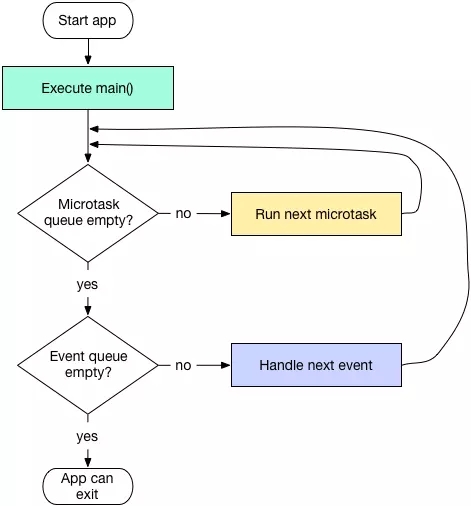Dart 属于单线程编程语言,在进行 I/O 操作或者其他耗时操作的时候,程序会进入阻塞状态。异步是 Dart 并发方案的基础。
事件循环
作为一个事件驱动语言,Dart 同样拥有事件循环(Event Loop,类似于 Android 中的Looper/Handler)。Dart 有两个队列,一个是微任务队列(MicroTask Queue),一个是事件队列(Event Queue)
- 微任务队列包含 Dart 内部的微任务,主要通过
scheduleMicrotask调度 - 事件队列包含外部事件,如 I/O、Timer、绘制事件等

从上图可以看出,Dart 处理事件循环的逻辑
- 首先处理所有微任务队列里的微任务
- 处理完所有微任务之后,处理事件队列里的一个事件
- 回到微任务队列继续循环
对于微任务队列,一次性全部处理,对于事件队列,一次只处理一个。
微任务和事件
微任务
dart:async定义了一个顶级函数scheduleMicrotask,使用其让代码以微任务的方式异步执行
import 'dart:async'; //下文不再显式导入 |
控制台输出
开始
结束
这是一个微任务
事件
使用Timer.run(callback)让代码以事件的方式异步执行
void main() { |
控制台输出
开始
结束
这是微任务0
这是微任务1
这是微任务2
这是一个事件
同时可以看出和 Java 使用new Thread(Runnable r)不同,在 Dart 中,微任务的执行顺序是有序的。
考虑下面的代码,会输出这是一个事件吗?
Timer.run(() { |
根据上面 Dart 处理事件循环的逻辑图,Timer.run永远不会被执行,因为scheduleMicrotask永远在执行。
仅仅使用回调函数实现异步很容易陷入“回调地狱(Callback hell)”,为此 Dart 引入了Future
Future
Future 封装了一系列静态函数完成异步操作,其内部通过scheduleMicrotask和Timer实现。此外还有一个then方法,接收一个名为onValue的闭包作为参数,该闭包在 Future 成功完成时被调用
| 函数 | 用途 |
|---|---|
| Future(FutureOr |
创建事件任务 |
| microtask(FutureOr |
创建microtask任务 |
| sync(FutureOr |
创建同步任务 |
| delayed(Duration duration, [FutureOr |
创建延迟任务 |
通过代码理解
void main() { |
输出结果
开始
结束
同步Future,执行同步代码
这是微任务0
这是微任务1
这是微任务2
Future创建微任务,通过scheduleMicrotask实现
then中的代码0
then中的代码1
捕获Error 抛出then中的错误
then任务完成
这是一个事件
普通Future,通过Timer实现//延迟2s
延迟Future,通过Timer实现
在dart:async中,除了 Future,还有 Completer,用来将具体的 Future 流程控制权交给开发者
var completer = Completer(); |
控制台输出
获得Completer中的future 返回的字符串
虽然 Future 缓解了回调地狱的问题,但如果串太多的then代码,可读性仍然会非常差,特别是各种 Future 嵌套的时候。与 JavaScript 类似,Dart 引入了async/await。
async 和 await
async 关键字修饰的函数与传统函数并无区别,只是将返回值类型使用 Future 进行了封装。
通过代码具体理解
void main() async { |
控制台输出
main
getInt: 2333
getString: hello
可以看到,调用async方法的代码转换成了异步任务。要想使之变成同步顺序,使用await关键字。不过需要注意的是,该关键字必须要在async函数中使用
void main() async { |
控制台输出
getInt: 2333
getString: hello
main
继续下面的例子
void main() { |
控制台输出为
main 0
Foo
Bar
main 1
from bar: hello
也就是说,在foo中,除了第一行代码以及bar()这一函数调用之外的其他代码均为异步执行。当使用await的时候,其右边会马上返回一个 Future 对象,下面的代码则会以then的形式运行。
上面的代码转换成 Future 风格
foo() { |
Generator
stream
stream 是 Dart 中一个长度不确定的值列表,可以是有限的或者无限的,重要的是我们不知道 stream 何时结束或已经结束。随时间改变的鼠标位置、所有素数的列表或者网络上的视频流,都可以看做一个 stream。
可以通过为 stream 注册一个或多个回调函数的方式,对其进行订阅监听。
yield
yield 语句被用于生成器函数内,目的是给生成的集合添加新的结果。yield 语句总是使它的表达式被求值,通常情况下,求值结果会被追加到外层生成器所关联的集合中。如果生成器是同步的,则关联的集合是一个 iterable;如果是异步的,则关联的集合是一个 stream。
此外,yield 也会因外层的生成器是否同步产生不同的行为:同步时 yield 会暂停外层生成器,直至调用moveNext且返回值为 true,异步时生成器的执行会继续。
异步
一个函数体标记有async*修饰符的函数,将作为 stream 的生成函数。下面的函数生成一个包含自然数序列的 stream
get naturals async* { |
运行main函数,控制台将输出
get a natural 0
get a natural 1
get a natural 2
当 naturals 被调用时,立即返回一个新的 stream,一旦 stream 被监听,函数体将运行,以便生成值来填充 stream。每一次迭代执行一次 yield 语句,k 将自增(由于 await 的存在,函数会有短暂停止),然后函数将继续执行并使用新的 k 值,该值将被 yield 追加到 stream 中。
同步
上述函数的同步形式
Iterable naturalsTo(n) sync* { |
通过一个混合编程的例子来体会两者的区别
Iterable nSync(n) sync* { |
控制台输出为
sync before k++ and k is 0
sync after k++ and k is 1
sync before k++ and k is 1
sync after k++ and k is 2
main
async before k++ and k is 0
async after k++ and k is 1
async before k++ and k is 1
async after k++ and k is 2